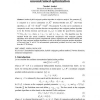Free Online Productivity Tools
i2Speak
i2Symbol
i2OCR
iTex2Img
iWeb2Print
iWeb2Shot
i2Type
iPdf2Split
iPdf2Merge
i2Bopomofo
i2Arabic
i2Style
i2Image
i2PDF
iLatex2Rtf
Sci2ools
NA
2008
2008
Another hybrid conjugate gradient algorithm for unconstrained optimization
Another hybrid conjugate gradient algorithm is subject to analysis. The parameter k is computed as a convex combination of HS k (Hestenes-Stiefel) and DY k (Dai-Yuan) algorithms, i.e. (1 )C HS k k k k DY k = - + . The parameter k in the convex combination is computed in such a way so that the direction corresponding to the conjugate gradient algorithm to be the Newton direction and the pair to satisfy the quasi-Newton equation( , )k ks y 2 1( )k k kf x s y+ = k, where and1k ks x x+= - 1 .k k ky g g+= - The algorithm uses the standard Wolfe line search conditions. Numerical comparisons with conjugate gradient algorithms show that this hybrid computational scheme outperforms the Hestenes-Stiefel and the Dai-Yuan conjugate gradient algorithms as well as the hybrid conjugate gradient algorithms of Dai and Yuan. A set of 750 unconstrained optimization problems are used, some of them from the CUTE library. MSC: 49M07, 49M10, 90C06, 65K
| Added | 14 Dec 2010 |
| Updated | 14 Dec 2010 |
| Type | Journal |
| Year | 2008 |
| Where | NA |
| Authors | Neculai Andrei |
Comments (0)

